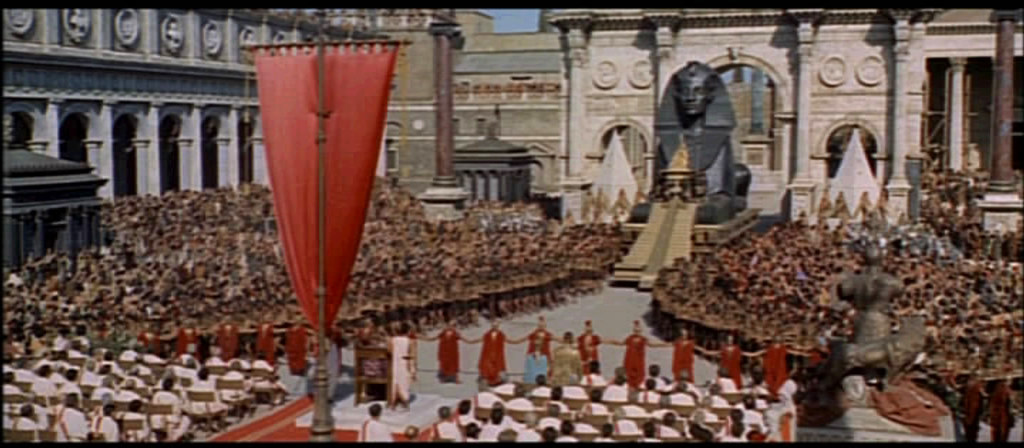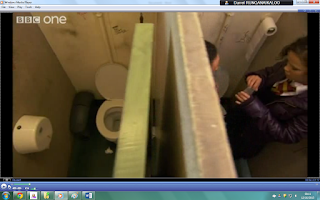Mid shot of female character, Martha Jones framed with two
security guards behind, signifying imprisonment, or that she is held captive.
In a mid shot, Martha glances to the left creating the impression that she is
looking at something or someone. Cut to a tracking shot left to right shot of three
‘servants’ apparently under arrest, signified by the uniformed guard who is
holding an armed rifle. Cut back to the framing of Martha Jones who is looking
nervously ahead, the camera shot is taken from a high angle, creating a
perspective of fear or not knowing.
Cut to a mid shot
of the Master, from a low angle, this suited character has a menacing
appearance to him, the camera cut back to the female as she then looks right,
signify continual awareness of what is around her. Cut to an a blackened faced
man who is also held captive (Captain Jack) who has ‘been in the wars’.
There is the use of
gradual zooms in this sequence of shots to signify the movement of the
character as slow, meaningful, perhaps hesitant? This is anchored by the
atmosphere of the music as is the Martha Jones who is on parade or about to
bow/ become subservient to the Master. • In contrast, earth is represented by
the shots of the female character, who is on a journey informing the people of
the crucial name they all need to chant: Doctor. Earth is represented as gloomy
and in danger. Earth’s inhabitants appear dull and dressed in mundane rags.
In metamorphosis the doctor is surrounded by a radiant blue light as he changes from a fragile old man to the his real self. The dominance of the field of light is a part of the special effect, which signifies an empowered Doctor. This can clearly be contrasted to the feeble old man who was caged by the Master. A rejuvenated doctor is strong, confident and at the top of his powers, signified by the ineffectiveness of the Master’s ray gun in trying to kill the Doctor.
The use of costume and performance is important to the
extract. The humans are represented by the ‘ordinariness’ of their costume and
actions. In contrast, the Master is bold smart and well presented, he is
surrounded by armed guards with weapons, the woman to his right in a red dress,
is represented as an object as she stands by his side, as do his uniformed male
helpers to his left.
For most of the extract the Master is positioned
powerfully in the frame whilst he controls the interior of the spaceship and
the characters, the Doctor undergoes a transformation when the Doctor becomes a
man again, he is reborn and becomes a powerful challenger to the Master’s
powers, which have evaded him by the end of the extract.
The exposure of the Master’s weapon ‘rings’ and the zap of
the laser gun at the end of the sequence, signifies weapon like qualities. These
sounds are diegetic and apart of the world of the drama. The pulses of music
are used to signify moments of flashback and function as signposts for these
narrative changes.
The wind is
harrowing as Martha Jones walks the earth and the metallic jingle, which
accompanies the Doctor’s metamorphosis signifies the magic of the
transformation.
Confidence is
exuded by the Master’s voice and the dialogue is important in the function of
the narrative, for example in his glee and oratory in destroying earth. The
voice of the Martha Jones is important and significantly develops and becomes
more pronounced, when the extract reveals her role as the messenger, this voice
changes from the timid to be more confident and louder as she explains her role
in the Master’s downfall.
The editing is characterised by the use of cut transitions
and the use of transitional flash effects to signpost past events. The pacing
of the extract is important at the beginning of the sequence it is slow and
orchestrated as the female character slowly marches towards the Master – this
slowness in the sequence of shots signifies her attention, to what is happening
around her.
The editing is more dramatic and faster paced when the
prime minister is controlling the technology and in conversation, where editing
provides continuity through the use of character perspective and functions to
carry the narrative forward.
There is plenty
evidence of the use of shot reverse shots, for example in dialogue between
Martha Jones and the Master. The use of the 180-degree rule is evidenced in the
dialogue led drama, these are combined with the shot selections outlined above.
The use of the shot reverse shot provides continuity in the narrative as the
plot is revealed and develops specific points of view for the audience,
particularly in relation to the conversation between Martha Jones and the
Doctor. Representation
Martha Jones is shown to be strong woman who acts independently and is a central character of the narrative and is a messenger. She is a
confident woman and she who helps the Doctor defeat the Master. She is
articulate and confident, yet calm under pressure. The Doctor’s victory was due to Martha spreading the message about the doctor thus helping him and thus sealing their victory.













